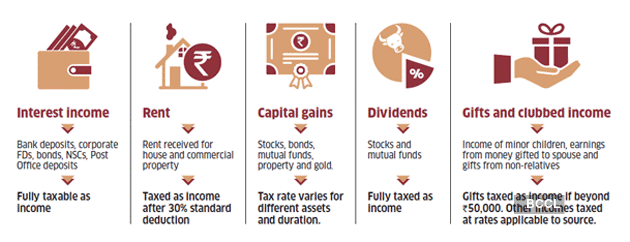Taxpayers should be aware of how incomes from other sources have to be reported in the tax return and know about the various deductions available to them. This week’s cover story looks at some of the incomes that might get missed by DIY taxpayers when they sit down to file their returns.

This is especially true for taxpayers who file their ITR on their own. They should be aware how incomes from other sources have to be reported in the tax return and know about the various deductions available to them. For instance, many taxpayers don’t report their interest income in their returns even though it is fully taxable. Many others do not report capital gains because mentioning the details of every transaction is very tedious. And a lot of taxpayers don’t even know that dividends are now fully taxable and must be mentioned in the return.
Other incomes to be reported in tax return

This week’s cover story looks at some of the incomes that might get missed by DIY taxpayers when they sit down to file their returns. We reached out to tax experts to know where taxpayers are likely to go wrong while calculating their tax and how they can accurately compute their tax liability.
We also looked at some of the tax rules that one should be aware of while preparing one’s tax return. For instance, there are now two tax regimes to choose from. “The new tax regime allows for lower tax rates but most of the deductions and tax benefits allowed in the old tax regime are not there,” says Archit Gupta, CEO and Founder of tax filing portal Cleartax.com. You have to select the tax regime before filing the income tax return. The taxpayer has to communicate the selection of tax regime by sending an intimation through Form 10IE to the income tax department before he files the return.
Salaried taxpayers might have already told their employers about the tax regime they want to go with. Their tax liability would have been accordingly calculated. If not declared, the employer will calculate the default TDS liability as per the old tax regime. However, the employee can make a switch at the time of filing his return.
Calculating capital gains
A major area of concern are capital gains and the tax on such income. With a large number of people taking to mutual funds and stocks in recent years, capital gains are now common. Besides, even long-term capital gains from equity mutual funds and stocks are now taxable beyond Rs 1 lakh, which means a lot more taxpayers are in this net. “Earlier, only about one in 10 taxpayers used to have capital gains. But now a substantially higher number are reporting such income,” says Karan Batra, chartered accountant and founder of Charteredclub.com.
Calculating capital gains is a complicated exercise, not only because you need to maintain records of all transactions but also because of the different tax rates applicable to various instruments. The new income tax filing portal was supposed to auto calculate and pre-fill the capital gains and tax in the tax form of an individual. However, that has not happened and all capital gains details have to be filled in the forms.
How capital gains are taxed
Reporting the capital gains and calculating the tax can be challenging because each transaction has to be entered in the tax return. Cleartax.com lists some common investments and the tax rates that apply to gains arising from them.

Adding to the complexity is the new rule that requires details of the scrips, buying price, selling price and dates of transactions to be mentioned in the return if the taxpayer has made long-term gains. The tax department has clarified that there is no need to mention scrip-wise details of transactions when reporting short-term gains.
The good news is that fund houses provide investors a capital gains statement that mentions all the transactions and gains made during the year. These statements not only segregate the short- and long-term gains but also calculate the indexation benefit. A capital gains statement can be quite elaborate, especially if the individual has invested through SIPs and made several redemptions during the year. Filling up details in the tax form can be quite tedious. But tax filing portal Cleartax allows taxpayers to upload their capital gains statements and all required fields automatically get populated.
Similarly, capital gains statements from specified stockbrokers and trading platforms (including Zerodha, ICICI Direct, Upstox and Groww) can be uploaded on the portal. If the statement is not in the same format, one can download an excel file from Cleartax and fill in the details. “Reporting capital gains can be challenging for a vast majority of taxpayers. Inputting details of every transaction may lead to errors. Taxpayers must use a platform that supports parsing of statements from brokerage houses and fund houses,” says Gupta of Cleartax. “That way they can be assured of accurate tax calculation and submitting an accurate income tax return,” he adds.
Don’t miss unlisted shares, foreign assets
While capital gains from listed shares and mutual funds have to be reported, taxpayers must also declare the unlisted equity shares and foreign assets they hold. Foreign assets held outside India (both as owner and as beneficiary) have to be mentioned in Schedule FA (foreign assets). There are stiff penalties waiting for non-compliance. Undisclosed foreign income or assets are taxed at 30% plus a penalty, which is 300% the tax payable on the income or value of the undisclosed asset. An additional penalty of Rs 10 lakh may be levied for failure to disclose such foreign assets in the return.
The foreign assets that need to be disclosed are foreign depository accounts, foreign custodial accounts, foreign equity and debt interest, shares held in any foreign company, and details of trusts created under the laws of another country in which the assessee is a trustee and any other capital asset.
Dividends are now taxable
Not many investors know that the dividends they receive from their mutual funds and stocks are now taxable. Till 2019-20, the tax on mutual fund dividends was deducted by the fund house itself, but the dividend distribution tax was removed last year and dividends are now fully taxed as income. Dividends from stocks also get the same tax treatment.
Tax experts say dividend income mentioned in the Form 26AS might get pre-filled in the tax form. “We are expecting that the dividend and interest income on which TDS has been deducted will be prefilled in the forms,” says Amit Maheshwari, Tax Partner, AKM Global.
But don’t count on Form 26AS alone, because companies deduct TDS from dividend payouts if they exceed a limit. Small dividend payments not subjected to TDS will obviously not be mentioned in Form 26AS. Yet, they need to be reported in the tax return. “Taxpayers should check the statements from their mutual funds, demat account and banks for the dividends received during the year,” says Batra.
Interest is also fully taxable
One lingering misconception among many taxpayers is the taxability of interest income. The interest earned on bank deposits, bonds and some small savings schemes is fully taxable, but many taxpayers choose to ignore this. Even the interest on savings bank balance has to be reported as “income from other sources” in the tax return. Although almost everyone has some interest income, three out of four people writing to ET Wealth for tax optimisation do not mention this.
Two years ago, the TDS threshold was raised to Rs 40,000 per year. Even if TDS is not being deducted, don’t assume that the interest income can escape the tax net. All interest payments are reported to the tax department by the financial institution paying the interest. Keep in mind that not only bank deposits, but even investments in Post Office schemes now require your PAN, and the information on the interest earned ultimately reaches the department.
Some taxpayers even believe that no tax is payable if their bank has deducted TDS on the interest. This is also a misconception. TDS is only 10% of the interest (20% if PAN is not provided). If a taxpayer is in a higher tax slab, he needs to pay additional tax on the interest. Check your interest income for the financial year in the Form 26AS. It will have details of the TDS deducted from interest payments. The income declared in your tax return must match the information in the Form 26AS, else be ready for a tax notice.
It’s a good idea to also report the exempted income such as the interest earned on tax-free bonds, PPF and the Sukanya Samriddhi Yojana in your tax return. You will find it easier to explain the credit of large sums when these investments mature if you have been reporting this income all along.
One common mistake that taxpayers make relates to the clubbing of income. Tax rules say that if money gifted by a spouse is invested, the income from that investment will be clubbed with that of the giver and taxed accordingly. “The law is very clear on this. Yet, we come across cases where property is jointly owned by a couple even though the entire money was paid by the husband. In such cases, the rental income cannot be divided between husband and wife. It will have to be reported as his income alone,” says Kaushik of Taxspanner. Likewise, income from investments made in the name of spouse and minor children will have to be added to the income of the giver.
Reconciling income and expenses
In recent years, the tax department has started examining expenses incurred by taxpayers. Rich taxpayers with a net taxable income of more than Rs 50 lakh in a financial year are required to also report details of specified assets such as land, building, movable assets, bank accounts, shares and bonds and the corresponding liabilities against those assets if any. Last year, it introduced a new Section E in the Form 26AS which mentions high-value transactions done during the year. These high-value expenses mentioned in the Form 26AS should match the income you declared in your return. “If a person spends Rs 10-12 lakh on his credit card and another Rs 3-4 lakh on foreign travel but declares an income of only Rs 6-7 lakh, the department will want to know how his expenses exceed his income,” says Maheshwari.